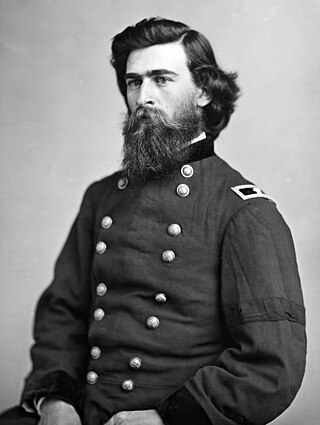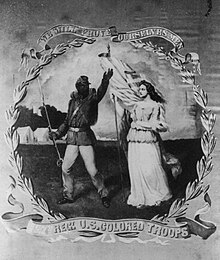
United States Colored Troops (USCT) were Union Army regiments during the American Civil War that primarily comprised African American soldiers, although troops drawn from other ethnic minorities also served in USCT units. Recruited in response to a demand for recruits from Union Army commanders, by the end of the war in 1865 USCT regiments, which numbered 175 in total, constituted about one-tenth of the manpower of the army. Approximately 20% of USCT soldiers were killed in action or died of disease and other causes, a rate about 35% higher than that of white Union troops. Numerous USCT soldiers fought with distinction, with 16 receiving the Medal of Honor. The USCT regiments were precursors to the Buffalo Soldier units which fought in the American Indian Wars.
Camp William Penn was a Union Army training camp located in Cheltenham Township, Pennsylvania from 1863 to 1865, notable for being the first training ground dedicated to African American troops who enlisted in the United Army during the American Civil War. Some 11,000 free blacks and escaped slaves were trained here, including 8,612 from Pennsylvania, the most black troops recruited during the war from any northern state.

Alexander Kelly was an African-American coal miner and native of Pennsylvania who fought with the Union Army as a member of the 6th United States Colored Infantry Regiment during the American Civil War. He was awarded his nation's highest military decoration—the U.S. Medal of Honor—for his gallantry in the Battle of Chaffin's Farm, Virginia on September 29, 1864.

The 5th United States Colored Infantry Regiment was an African American regiment of the Union Army during the American Civil War. A part of the United States Colored Troops, the regiment saw action in Virginia as part of the Richmond–Petersburg Campaign and in North Carolina, where it participated in the attacks on Fort Fisher and Wilmington and the Carolinas Campaign.
Alonzo Granville Draper was a volunteer officer in the Union Army during the American Civil War who eventually earned the grade of brevet brigadier general. During his early career, Draper was an outspoken advocate of various social causes, particularly worker's rights. As an officer during the Civil War, Draper was best known as the commander of the 36th United States Colored Troops.

David Bustill Bowser was a 19th-century African-American ornamental artist and portraitist.
Company "A", Pennsylvania (Colored) Infantry was a United States Colored Troops unit briefly formed during the Civil War in the Union Army. The unit was organized at Camp William Penn, Pennsylvania on July 28, 1864 It was named for its commander, Captain Converse Southard. The unit was disbanded November 14, 1864 at Philadelphia, Pennsylvania and its remaining members sent to reinforce existing U.S.C.T. regiments.
The 7th United States Colored Infantry was an infantry regiment that served in the Union Army during the American Civil War. The regiment was composed of African American enlisted men commanded by white officers and was authorized by the Bureau of Colored Troops which was created by the United States War Department on May 22, 1863.
The 8th United States Colored Infantry was an infantry regiment that served in the Union Army during the American Civil War. The regiment was composed of African American enlisted men commanded by white officers and was authorized by the Bureau of Colored Troops which was created by the United States War Department on May 22, 1863.
The 9th United States Colored Infantry was an infantry regiment that served in the Union Army during the American Civil War. The regiment was composed of African American enlisted men commanded by white officers and was authorized by the Bureau of Colored Troops which was created by the United States War Department on May 22, 1863.
The 41st United States Colored Infantry was an infantry regiment that served in the Union Army during the American Civil War. The regiment was composed almost entirely of African American enlisted men and commanded by white officers. The regiment was authorized by the Bureau of Colored Troops which was created by the United States War Department on May 22, 1863. The regiment engaged in the Siege of Petersburg and Appomattox Campaign and was present at the unconditional surrender of Confederate General Robert E. Lee and the Army of Northern Virginia at Appomattox Court House on April 9, 1865.

Llewellyn Frost Haskell was a Union Army officer during the American Civil War.
The 19th United States Colored Infantry was an infantry regiment that served in the Union Army during the American Civil War. The regiment was composed of African American enlisted men, mostly from southern Maryland and that state's Eastern Shore. Commanded by white officers, it was authorized by the Bureau of Colored Troops which was created by the United States War Department on May 22, 1863.

The 45th United States Colored Infantry was an infantry regiment of the Union Army during the American Civil War.

The 22nd United States Colored Infantry was an infantry regiment that served in the Union Army during the American Civil War. The regiment was composed of African American enlisted men commanded by white officers and was authorized by the Bureau of Colored Troops, which was created by the United States War Department on May 22, 1863.
The 36th United States Colored Infantry was an infantry regiment that served in the Union Army during the American Civil War. The regiment was composed of African American enlisted men commanded by white officers and was authorized by the Bureau of Colored Troops which was created by the United States War Department on May 22, 1863.
The 43rd United States Colored Infantry was an infantry regiment that served in the Union Army during the American Civil War. The regiment was composed of African American enlisted men commanded by white officers and was authorized by the Bureau of Colored Troops which was created by the United States War Department on May 22, 1863.

William Henry Egle (1830–1901) was a physician, author and historian who served as the State Librarian of the Commonwealth of Pennsylvania from 1887 to 1889. A practicing physician at the dawn of the American Civil War, he was initially commissioned as an assistant surgeon, and then served as a surgeon with several different Union Army regiments during the course of the conflict, including the 116th Regiment Infantry, U.S. Colored Troops (USCT).
The 61st United States Colored Infantry was an infantry regiment that served in the Union Army during the American Civil War. The regiment was composed of African American enlisted men commanded by white officers and was authorized by the Bureau of Colored Troops which was created by the United States War Department on May 22, 1863. The non-commissioned officers (sergeants and corporals) and enlisted men were African Americans. The regiment was originally organized as the 2nd Tennessee Volunteer Infantry (African Descent) and was also referred to as the 2nd West Tennessee Infantry Regiment (African Descent).

The 3rd United States Colored Infantry Regiment was an infantry regiment that served in the Union Army during the American Civil War. The regiment was composed of African American enlisted men commanded by white officers and was authorized by the Bureau of Colored Troops which was created by the United States War Department on May 22, 1863.









